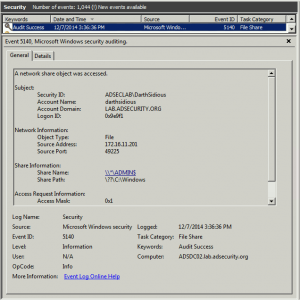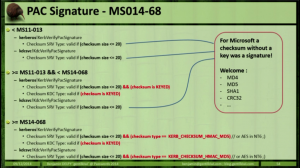MS14-068 References: AD Kerberos Privilege Elevation Vulnerability: The Issue Detailed Explanation of MS14-068 MS14-068 Exploit POC with the Python Kerberos Exploitation Kit (aka PyKEK) Exploiting MS14-068 Vulnerable Domain Controllers Successfully with the Python Kerberos Exploitation Kit (PyKEK) This post shows the packet captures I performed using WireShark on the Domain Controllers during stage 1 and …
Tag: KDC
Dec 07 2014
Exploiting MS14-068 Vulnerable Domain Controllers Successfully with the Python Kerberos Exploitation Kit (PyKEK)
MS14-068 References: AD Kerberos Privilege Elevation Vulnerability: The Issue Detailed Explanation of MS14-068 MS14-068 Exploit POC with the Python Kerberos Exploitation Kit (aka PyKEK) Detecting PyKEK Kerberos Packets on the Wire aka How the MS14-068 Exploit Works After re-working my lab a bit, I set about testing the MS14-068 POC that Sylvain Monné posted to …
Nov 18 2014
MS14-068: Vulnerability in (Active Directory) Kerberos Could Allow Elevation of Privilege
Active Directory leverages the Kerberos protocol for authentication. The vulnerability patches an issue with how the Domain Controller validates group membership in Kerberos tickets (hint: the ticket is always validated by the DC if the checksum is set to certain values). Microsoft KB3011780 patches this issue. According to Microsoft: “When this security bulletin was issued, …
Sep 12 2014
Kerberos, Active Directory’s Secret Decoder Ring
Kerberos Overview Kerberos is a protocol with roots in MIT named after the three-headed dog, Cerberus. Named because there are 3 parties: the client, the resource server, and a 3rd party (the Key Distribution Center, KDC). Kerberos can be a difficult authentication protocol to describe, so I will attempt to simplify it as best as …





Recent Comments